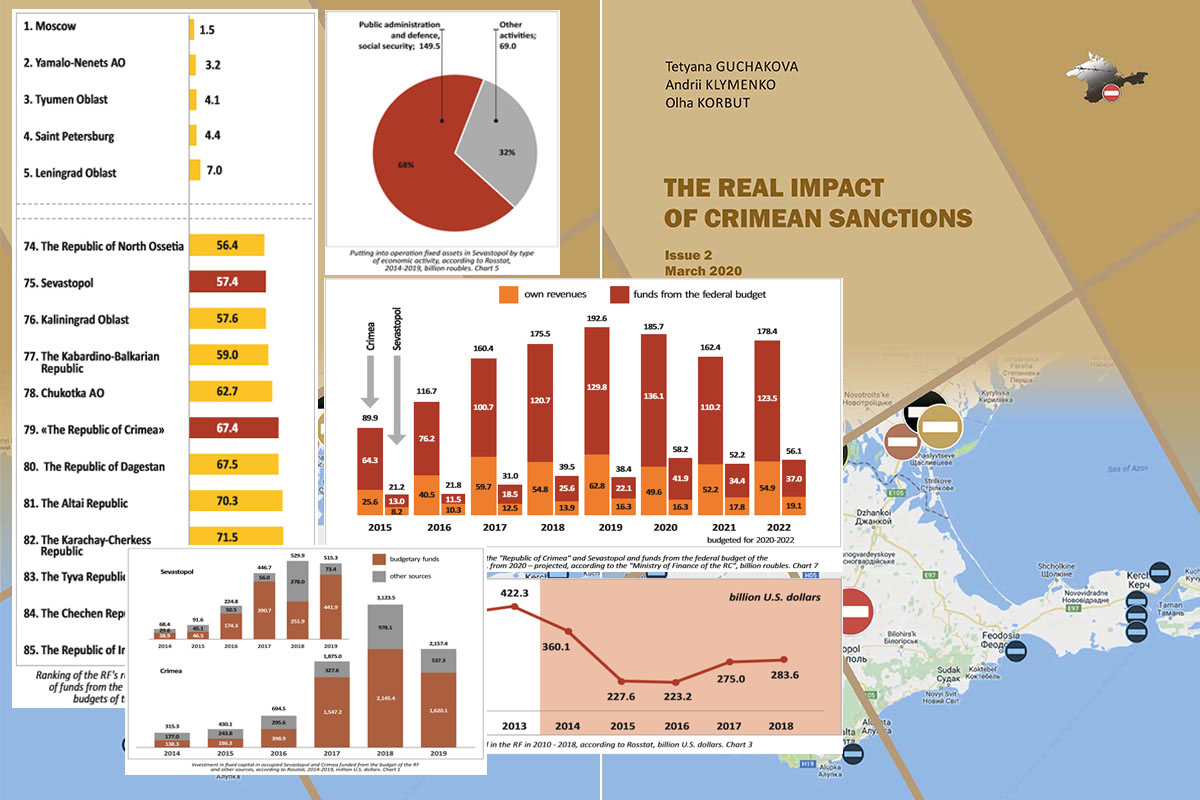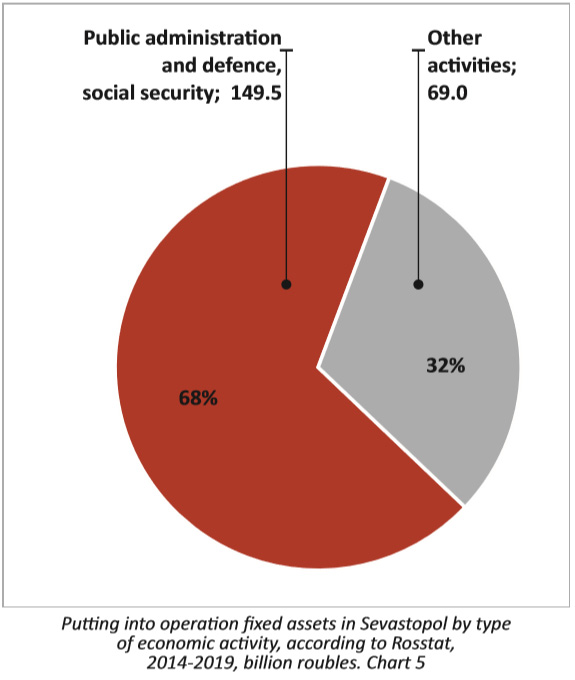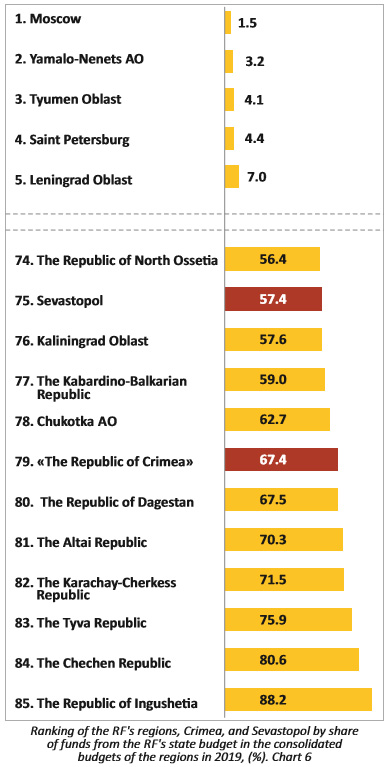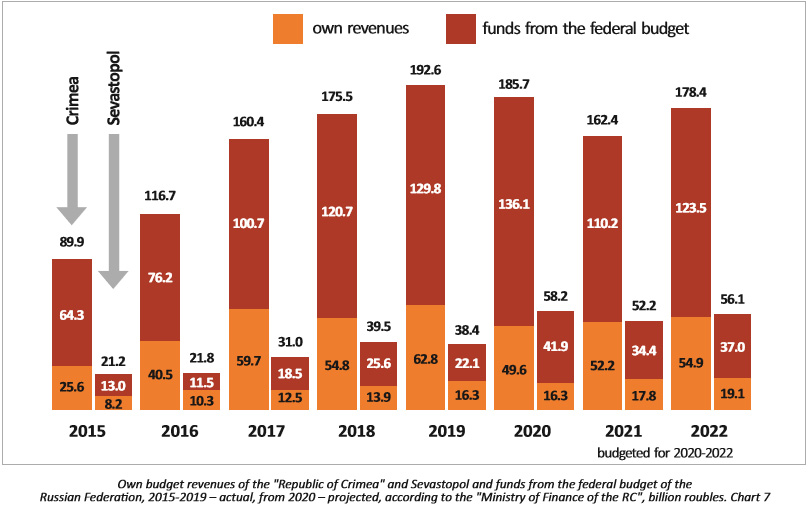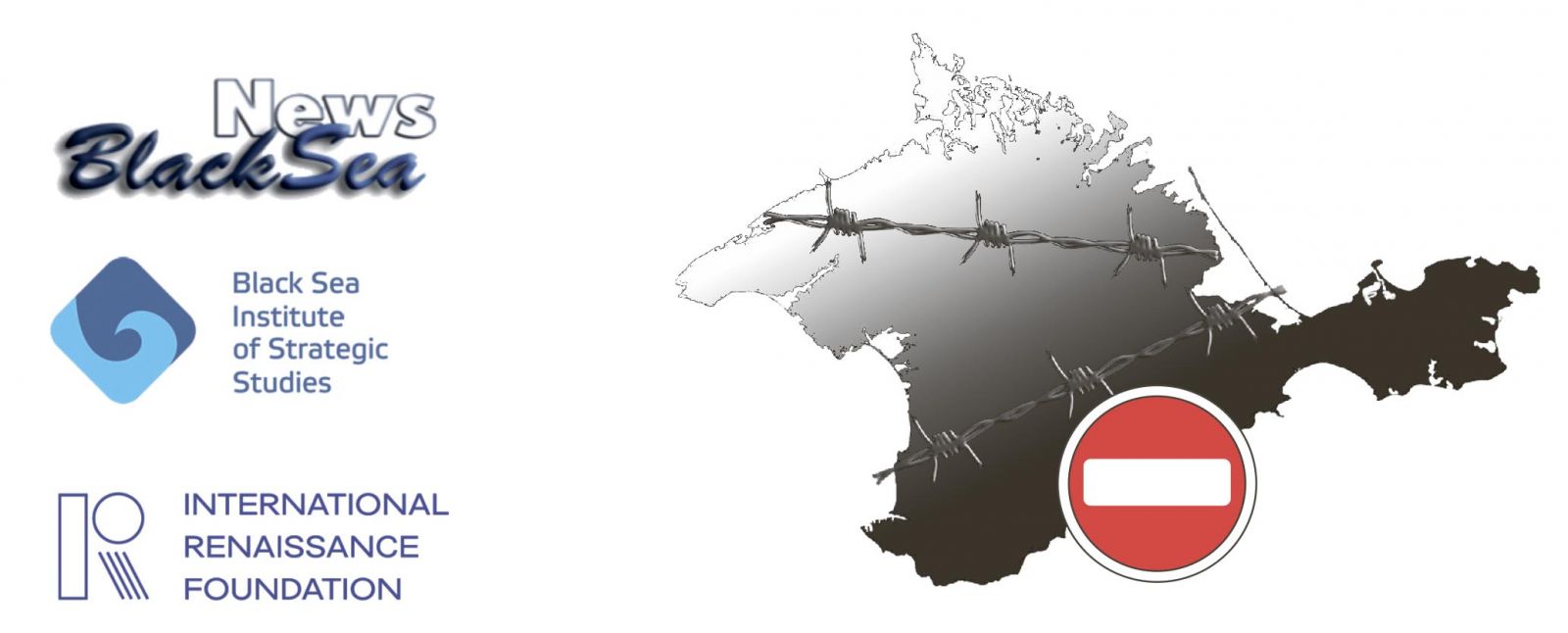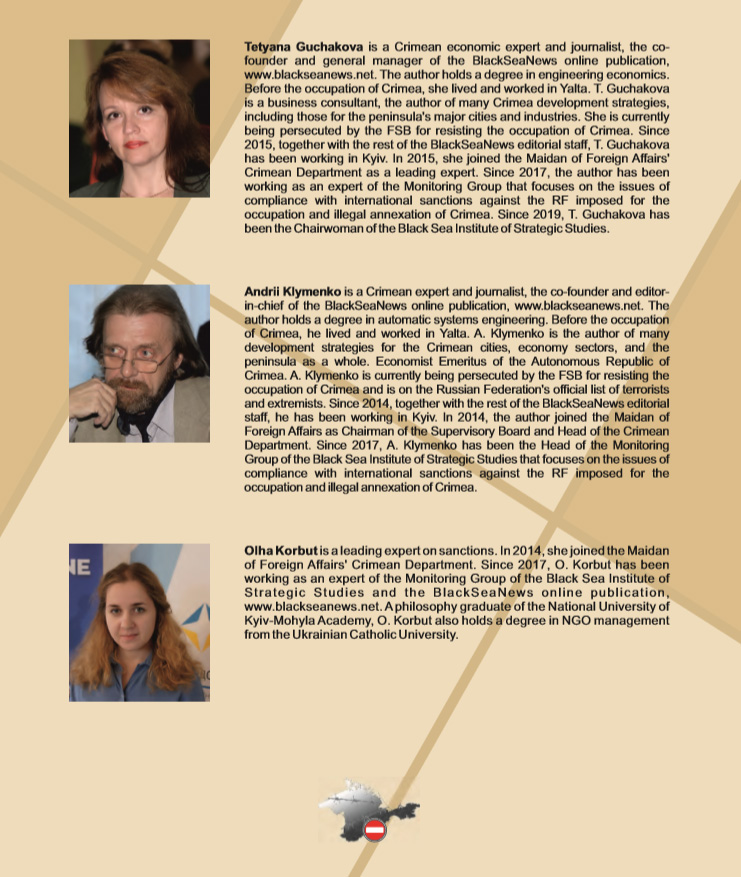The Real Impact of Crimean Sanctions (6-8). The Peculiarities of Economic Processes in Russia and Occupied Crimea under Sanctions
Andrii KLYMENKO,
Tetyana GUCHAKOVA,
Olha KORBUT
The Monitoring Group of the Black Sea Institute of Strategic Studies and BSNews
Translated from Ukrainian by HANNA KLYMENKO
The BlackSeaNews presents a series of publications on the real impact of Crimean sanctions on Russia's economy.
The contents include:
Crimea Occupation, Sanctions, and Blockade. The State of the Sanctions Regime as of 1 February 2020
The Impact of Sanctions on the Crimean Banking
The Impact of Sanctions on Maritime Connections with the Occupied Crimean Peninsula
Missed Deadlines for the Production of Karakurt Missile Corvettes at the Morye Shipyard in Feodosia
The Imposition of U.S. Sanctions against Russian Plants over the Production of Warships in Crimea
The Peculiarities of Economic Processes in Russia and Occupied Crimea under Sanctions
Russia's Investment in Fixed Capital in Occupied Crimea and Sevastopol. What Russian Investment Money is Spent on in Crimea and Sevastopol
The Heavily Subsidised Budget Model of Crimea and Sevastopol
The Updated "Crimean Sanctions Package"
The Policy of Non-recognition of the Attempt to Annex the Crimean Peninsula
The Cost of the Occupation to Russia and What Awaits Crimea and Sevastopol
The Peculiarities of Economic Processes in Russia
and Occupied Crimea under Sanctions
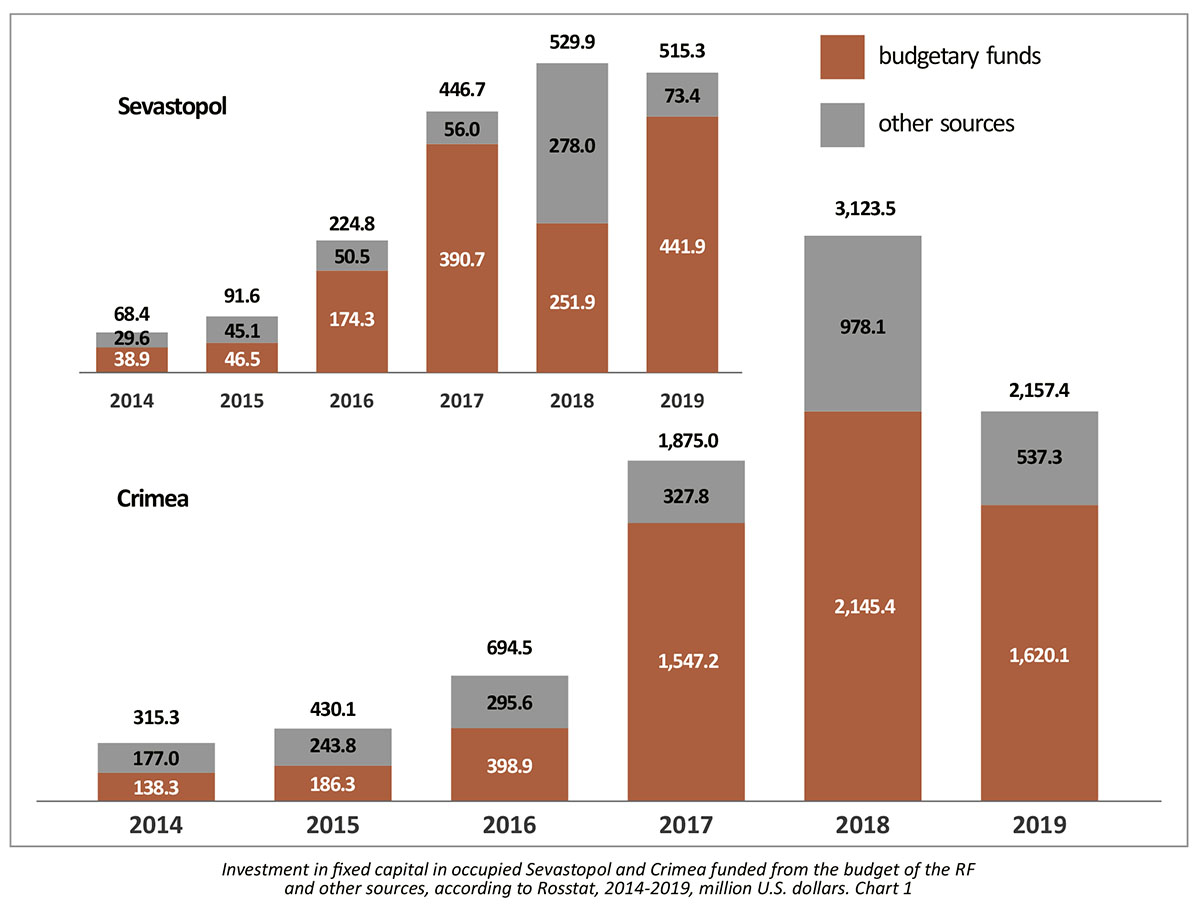 During the period of the occupation of Crimea, the authors repeatedly referred in their studies not only to the analysis of particular industries or types of economic activity but also to the peculiarities of general processes in the Crimean economy under sanctions¹.
During the period of the occupation of Crimea, the authors repeatedly referred in their studies not only to the analysis of particular industries or types of economic activity but also to the peculiarities of general processes in the Crimean economy under sanctions¹.
At the time of this publication, the economic processes on the peninsula (for all their "exoticism" in the world of the market economy) have already become established for the long run. As long as there is the occupation and sanctions regime, no fundamental changes can be expected.
It is worth reminding that the first year of the occupation – until the summer of 2015 – was the year of certain "imperial romancism". It was characterised by the "Russian nationwide fountain of optimism and investment ideas" of creating a "new showcase for Russia" on the seized peninsula – with "Silicon Valley", nanotechnology, a gambling zone, a "flagship" free economic zone, and 7-star resorts...
For this purpose, on 31 March 2014, the "Ministry of Crimean Affairs" was created, and later thousands of investment scouts from large and small corporations from Russia and other countries went to the peninsula.
In fact, as our studies² show, from the outset, the main objective of the Russian Federation was to create in Crimea an unprecedented symbiosis of a huge military base and an economically self-sufficient region in order to minimise the budget expenditure of the Russian Federation, rather than an "investment paradise" for the new citizens.
The regime of international sanctions and blockade was a huge surprise for the Russian authories.
As early as the first half of 2015, they realised the fallacy of their original concept, and on 15 July 2015, the "Ministry of Crimean Affairs" was dissolved.
One year later, on 28 July 2016, the status of "new Russia" was lowered – the "Crimean Federal District", which had been created on 21 March 2014, on the third day after the act of annexation, was liquidated.
The so-called "constituent entities of the Russian Federation" the Republic of Crimea and the city of Sevastopol were merged into the Southern Federal District of the RF with the administrative centre in Rostov-on-Don.
The peculiarities of the real "economic model of Crimea", which can be described in two words: "militarisation" and "sanctions", should be taken into account when analysing the Russian statistics in general, and those for Crimea and Sevastopol in particular.
After the occupation and imposition of sanctions, these statistics turned into a propaganda tool and an instrument for concealing the real state of the economy.
In addition, the imposition of sanctions prompts the RF to hide an ever-increasing amount of information related to the occupied peninsula and activities that fall under or may fall under sanctions. All previously public information of the Russian Federation on state defence orders has been classified.
Therefore, some conclusions and generalisations can only be made by comparing the statistics and information flow.
|
Analysing the situation in Crimea, one should take into account the peculiarities of the "Russian model of the peninsula", turning Russia's official statistics into a propaganda tool and an instrument for concealing the real state of the economy after the imposition of sanctions, the restrictions on access to a vast amount of information. |
1. T. Guchakova, A. Klymenko. "The Socio-Economic Situation in the Occupied Crimea in 2014-2018". – Kyiv. 2019. "The Gray Zone". The Crimean Peninsula: The Four Years of Occupation". (The annual report "Occupied Crimea under Sanctions and Blockade in 2014-2017"). Edited by A. Klymenko. – Kyiv. 2018.
2. A. Klymenko. T. Guchakova. “The Militarization of Crimea as a PanEuropean Threat”. Based on the data gathered by the joint Monitoring Group of the Maidan of Foreign Affairs, the Black Sea Institute of Strategic Studies, and the BlackSeaNews online portal (www.blackseanews.net). With contributions by O. Korbut. Kyiv. 2019
Russia's Investment in Fixed Capital in
Occupied Crimea and Sevastopol
According to Rosstat, during the years of the occupation, investment in fixed capital in Crimea and Sevastopol has totalled $8.6 billion and $1.9 billion respectively. Of this investment, $6.03 billion (70.2%) in Crimea and $1.34 billion (71.6%) in Sevastopol was funded from the state budget (see Chart 1).
This was mainly the investment in the facilities under the so-called Federal Target Programme "The Socio-Economic Development of the Republic of Crimea and Sevastopol until 2020" (hereinafter referred to as "the FTP"), as shown in Chart 2.
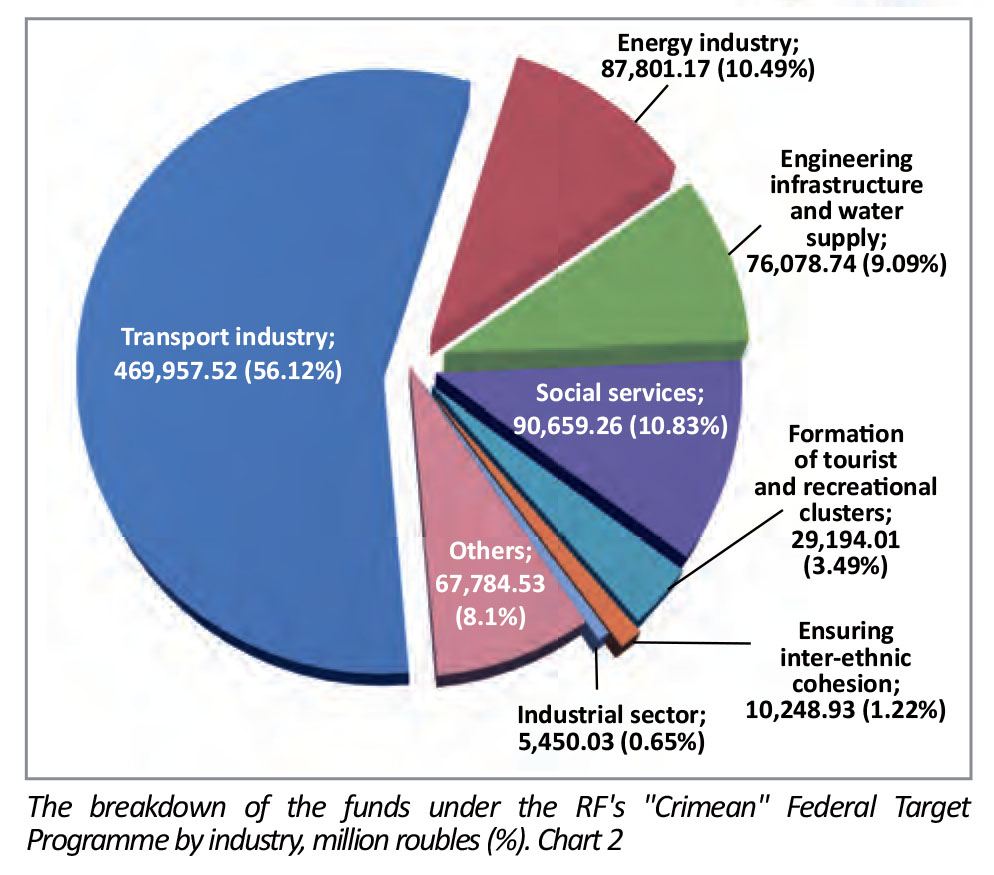 The authors have thoroughly analysed the FTP at various stages of its adoption, correction, and implementation.
The authors have thoroughly analysed the FTP at various stages of its adoption, correction, and implementation.
It is worth reminding that the size of the FTP for 2015-2020 was 837,174.19 million roubles, including the funds from the federal budget – 94.5%, from the budgets of constituent entities of the Russian Federation – 1.9%, and from extrabudgetary sources – 3.6%.
Almost 76% of the FTP funds were spent on implementing megaprojects in the areas of transport (56.12%), energy (10.49%), engineering infrastructure and water supply (9.09%):
• an underwater power cable and gas pipeline, road and railway bridges across the Kerch Strait;
• two power plants with notorious Siemens turbines in Sevastopol and Simferopol;
• the Tavrida motorway from Kerch to Sevastopol;
• the reconstruction of the airport in Simferopol and many smaller-scale projects.
Apart from 70% of budget investment in fixed capital, the considerable size of investment "from other sources" in occupied Sevastopol and Crimea during the occupation years – $532.6 million and $2,559.6 million respectively – deserves attention (See Chart 1).
 The "other sources" of investment in Crimea and Sevastopol are as follows:
The "other sources" of investment in Crimea and Sevastopol are as follows:
• investments from enterprises of the military industrial complex of the RF in military production at Ukrainian plants seized as a result of the occupation;
• investment in the construction of road and energy infrastructure, other facilities under the FTP, the funds for which were allocated not directly from the budget of the Russian Federation, but through Russian state and quasi-private corporations or bank loans;
• private investment in housing construction for customers from the RF is almost the only type of demand-oriented investment projects. The customers, in turn, represent a specific group of Russian military and government officials transferred to the peninsula. Also, private investment in trade and warehouse infrastructure of wholesale and retail businesses from the regions of the RF is made.
|
In 2014-2019, Russia's investment in fixed capital in the "Republic of Crimea" and the city of Sevastopol totalled $8.6 billion and $1.9 billion respectively. 70.2% of the investment in Crimea and 71.6% in Sevastopol was funded from the RF's state budget. |
Note that this "island story", where until 2019, investment in fixed capital in Crimea that came from the RF's budget increased, unfolds against the backdrop of a dramatic decrease in investment in fixed capital in the Russian economy as a whole, as a result of the aggression against Ukraine and international sanctions (see Chart 3).
As the Russian economist Vladislav Inozemtsev explained, "since 2014, over 200 foreign companies have ceased their operations in Russia, and in 2018, Russian entrepreneurs closed their businesses 2.15 times more often than they started new ones. Only efforts of the state, whose share in total investment reached 18%, excluding the investment programmes of state companies, helped avoid the collapse of investment in fixed capital" (3).
|
$26.6 bn of Russian investment in fixed capital on the occupied peninsula caused by the blockade of Crimea should be compared with the loss of $200 bn of such investment in Russia as a result of the flight of foreign capital and the curtailment of Russian business due to the war and sanctions. |
Note that Russia's investments in infrastructure megaprojects on the territory of the Crimean peninsula were largely forced – the urgency of making these investments was a direct consequence of the occupation of Crimea, that is, of the international sanctions regime and the trade, transport, water, and infrastructure blockade by the mainland Ukraine caused by the occupation.
What Russian Investment Money is Spent on
in Crimea and Sevastopol
As the following topic is quite specialised, for the convenience of those readers who do not deal with accounting on a day-to-day basis, let us recall the following definition:
Fixed assets are tangible assets (such as property, plant, and equipment) held by an enterprise or organisation for using them in the production process or for performing management functions. Fixed assets have an expected life of more than one year (or longer than an operating cycle if it exceeds a year).
The presence of this topic in our review is explained by the results given in the charts (see Charts 4 and 5), above all – by the type of economic activity marked in red.
In the official RF's classification², this type of activity has code 84 and the name "Public administration and defence, compulsory social security".
The main ingredient of this Russian cocktail of military defence and social security is the activity listed under code 84.22, "Defence activies".
"...This class includes administration, supervision, and operation of military defence affairs and land, sea, air and space defence forces such as:
• combat forces of army, navy, and air force,
• engineering, transport, communications, intelligence, material, personnel forces and commands,
• reserve and auxiliary forces of the defence establishment,
• military logistics (provision of equipment, supplies, structures, etc.),
• health activities for military personnel in the field... ".
Thus, the red segments of the charts, especially the one on Chart 5, which applies exclusively to Sevastopol, the main base of the Black Sea Fleet of the RF, indicates that over the years of the occupation, military facilities and equipment worth up to 150 billion roubles have been put into operation in Sevastopol.
These facilities and equipment were assigned to the Black Sea Fleet and naval aviation headquarters located in the city.
The fact that defence activities account for about 70% of fixed assets put into operation in Sevastopol demonstrates which industry has been given the highest priority in the city's economy.
The so-called "Republic of Crimea" has somewhat different tasks, which is shown in Chart 4.
Our analysis of Russian investment activity on the peninsula has demonstrated the following: the main reason for the existence of the occupied Crimea territory for the RF is to provide transport and critical infrastructure transit from the territory of the RF to the military base in Sevastopol across the Kerch Strait.
This "mission" consists of the following priorities:
• providing logistics support – reliable and fast transportation of troops, armoured vehicles, missiles and shells, fuel and other supplies from the territory of the RF to military bases and airfields located in or operated from Sevastopol;
• providing logistics support to Russian military bases in Syria and the Russian Navy squadrons in the Mediterranean
• providing military facilities with engineering infrastructure – water supply, sewerage, heat supply, power supply, gas supply, and communication systems (the provision of this infrastructure to the population of the peninsula is funded residually);
• providing critical services, such as health care, trade, for members of the Russian armed forces, civil servants, law enforcement officers, and their families (the provision of these services to the rest of the population is funded residually).
|
The main reason for the existence of occupied Crimea for Russia is to provide transit from the territory of the RF for everything the military base in Sevastopol needs. |
1. https://echo.msk.ru/blog/openmedia/2511987-echo/
2. OKVED – the Russian Classification of Economic Activies OK 029—2014 (NACE Rev. 2). Approved by Order of Rosstandart of 31 January 2014 No. 14-st, entered into force on 1 February 2014, the previous revisions of OKVED were repealed on 1 January 2015.
The Heavily Subsidised Budget Model
of Crimea and Sevastopol
After 2015, it became clear that the regime of international sanctions and the blockade of the occupied peninsula by mainland Ukraine made not only economic development but also financial selfsufficiency of Crimea and Sevastopol impossible.
Since then, the analysis of the budgets of Sevastopol and the "Republic of Crimea" has lost its economic sense.
The basis and, at the same time, the main intrigue of the annual budgeting on the Crimean peninsula are the same – the size of the government subsidy from the Russian Federation.
That is, due to the sanctions the Russian Federation was forced to move to the only possible "economic model" for occupied Crimea, the main features of which are as follows:
• "the island of Crimea" is isolated from the civilised world and connected only with the Russian Federation by the bridge across the Kerch Strait, the underwater power cable and gas pipeline, and by air;
• almost 70% of the "island's" expenses are covered by the budget subsidies from the Russian Federation; some income comes from the sale of "trophy" Ukrainian property, the buyers of which are Russian companies and individuals subject to international sanctions;
• the reason for the existence of the "island" is perhaps the world's largest military base of global geopolical importance with the latest weapons; the main activities are the production, repair, and maintenance of military equipment, housing construction for the Russian military, intelligence officers, and officials;
• investment in "civilian" infrastructure projects is made to address the problems created by the occupation;
• the civilian, military, industrial, logistical, and service infrastructure of the "island" is created mainly on the basis of "trophy" Ukrainian property; its development and maintenance are funded by the Russian government – be it budgetary investments or the funds of state and quasi-private companies; this work is performed mainly by Russian companies subject to sanctions;
• all state-financed projects, programmes, and investment carried out on the "island" also serve a traditional for the RF purpose of enriching those who are assigned to implement them.
In 2019, own revenues accounted for only 32.6% of the revenues of occupied Crimea's republican and municipal budgets; the remaining 67.4% of the funding came from the budget of the Russian Federation.
In terms of the level of subsidy, occupied Crimea is in the same group as the most subsidised regions of the Russian Federation: the republics of the North Caucasus (Chechnya, Ingushetia, Karachay-Cherkessia, Dagestan) and such remote areas as Altai, Tyva, and Chukotka.
|
The opmistic hopes for "trophy" Crimea's selfsufficiency are gone forever: the occupied peninsula will never become financially selfsustaining. In Crimea itself, they expect to be permanently funded from the Russian budget, which causes irritation in the RF. |
A certain increase in revenues in 2019 was artificial – for this purpose, the legal addresses of some companies involved in the construction of the bridge across the Kerch Strait were transferred to Crimea for them to pay taxes to the Crimean budget.
Due to the completion of the megaprojects, such revenues are no longer projected (see Chart 7).
The slightly lower level of Sevastopol's dependence on subsidies is explained only by the fact that, as a result of the militarisation during the occupation, many members of the Russian armed forces and their families, who have quite high incomes and pay taxes to the local budget, have moved to the city. According to the authors' estimates, during the occupation, the population of Sevastopol has increased by at least 15%.
To be continued...
* * *
The monitoring of violations of international sanctions against Russia and of the legal regime of the Crimean temporarily occupied territory, as well as the publication of this book, have been supported by the European Program of the International Renaissance Foundation. The views of the authors do not necessarily reflect the position of the International Renaissance Foundation.
More on the topic
- 01.07.2021 The Electronic Catalogue Research by Western Think Tanks on Crimea and the Situation in the Black Sea
- 22.01.2021 How the Sanctions Work. The Defense Industry of the Occupied Crimea
- 11.06.2020 The Maritime Expert Platform Association on Urgent Actions to De-Occupy Crimea and Counter the Occupation of the Sea of Azov and the Black Sea. Proposals
- 06.06.2020 The Real Impact of Crimean Sanctions (10-11). The Cost of the Occupation to Russia and What Awaits Crimea and Sevastopol
- 06.06.2020 The Real Impact of Crimean Sanctions (9). The Updated "Crimean Sanctions Package"
- 18.05.2020 The Real Impact of Crimean Sanctions (5): the Imposition of U.S. Sanctions against Russian Plants over the Production of Warships in Crimea
- 09.05.2020 The Real Impact of Crimean Sanctions (4). Missed Deadlines for the Production of Karakurt Missile Corvettes at the Morye Shipyard in Feodosia
- 07.05.2020 The Impact of Sanctions on Maritime Connections with the Occupied Crimean Peninsula (3)
- 05.05.2020 The Real Impact of Crimean Sanctions (2). The Impact of Sanctions on the Crimean Banking
- 04.05.2020 The Real Impact of Crimean Sanctions (1). The State of the Sanctions Regime as of 1 February 2020
- 03.03.2020 The policy of non-recognition of the attempt to annex the Crimean peninsula
- 13.02.2020 Russia's Economic War Against Ukraine in the Sea of Azov as of February 1, 2020. The Technology of Blocking the Mariupol and Berdiansk Ports
